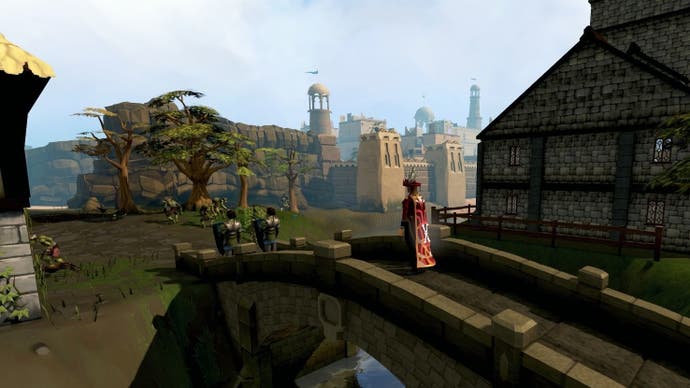The fascinating theory that explains RuneScape's illogical geography
There and back again.
From the southern Feldip Hills to the barren waste of the Wilderness, Gielinor, RuneScape's setting, is home to a collection of countries and kingdoms, within which lie cities and towns, many hiding dungeons beneath their streets. Beyond the borders of these settlements you can find ancient ruins, ghast infested swamps, a portal for interplanetary travel and even a spa. Yet, the more you explore the world of RuneScape, the more you'll start to notice that something is slightly wrong with Gielinor's geography.
How does climbing Ice Mountain, a peak so high that it's the only place in Asgarnia always covered in snow, take less than 30 seconds? Why do characters act like certain towns are miles apart, but, when you undertake the journey, it takes five minutes by foot? Most of all - how is Lumbridge, the quintessential country town (goblin problem aside), literally a short walking distance away from the Kharidian Desert?
I don't need my geography GCSE to tell me that something isn't quite right here. Thankfully, the RuneScape community has an answer in the form of scale theory and, before you ask, it has nothing to do with that flat earth - sorry, flat Gielinor - nonsense.
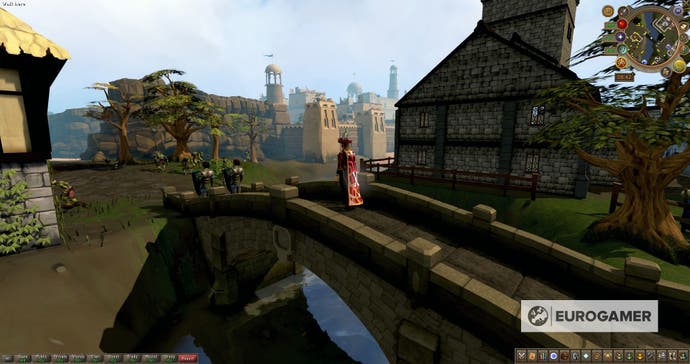
To the uninitiated, scale theory is the belief that the Gielinor we explore in RuneScape is not a true representation of Gielinor as a planet, instead it's a small, scaled down, version of the world. Scale theory proposes that Gielinor has been shrunk down to suit the confines of a video game which has led to a large part of the natural landscape - open field, rolling hills and maybe even additional settlements - being omitted to create an easy-to-navigate map and, if Gielinor was an actual plane of existence, it would be far larger than the one depicted in RuneScape. This theory is used to explain the multiple illogical, often strange, climate changes that occur across Gielinor and how the distances between certain locations are shorter than described.
There are multiple interpretations of scale theory, one being that players experience Gielinor through a gamified viewpoint, which makes it impossible for anyone to truly comprehend what the planet is truly like. Instead, using an adventurer as a conduit, we explore a summarised version of Gielinor constructed out of the major communities and landmarks within each country. The foundations of this interpretation are the multiple fourth wall breaks that occur throughout RuneScape; the most famous of which being a short conversation with the bartender at the Blue Inn in Varrock.
If you ask for advice on making your fortune, the bartender will comment that answering will "make the computer game too easy" and, if you question him about this, he will explain that "The world around us… is a computer game… called RuneScape," describing a computer as a "magic box thing, which can do all sorts of stuff." Not only does this reveal that certain members of the RuneScape universe are aware that they exist within a video game, but, by highlighting how our adventurer is unaware of this fact, does suggest that there's a difference between what we see on the screen and what's naturally occurring in Gielinor. This interpretation is further supported by how the oldest elder god, the beings that created Gielinor and it's universe, is called Jas. A name that could reference the Java Application Server, which is the application that drives the RuneScape game engine.

The most popular version of scale theory, however, is the belief that a certain amount of Gielinor has been hidden from view; miles have been condensed into mere steps, mountain ranges have shrunk and cities like Faladar have barely over 20 buildings, despite being described as a heavily populated capital city. Walking from Port Tyras in Tirannwn, the most westerly point on the main continent of Gielinor, to Port Phasmatys, the farthest to the east, may only take you under 20 minutes in-game, yet, by acknowledging scale theory, you'll realise that this trip most likely took your adventurer weeks. Scale theory may sound like a hypothesis created to explain away the packed nature of a map that has been altered multiple times over the course of nearly 20 years, but, within RuneScape, you can actually find evidence to support it.
During your RuneScape adventuring, you may find yourself travelling through a location that only appears in a minigame or quest. In the minigames Temple Trekking and Burgh de Rott Ramble, for example, you escort travellers through the Mort Myre Swamp and every location you visit is inaccessible on the regular Gielinor map, indicating that the bog is far larger and more labyrinthine then we are led to believe. While these sections of the swamp do merely exist for the purpose of the minigame, scale theory proposes that these locations are, in fact, always present within Mort Myre, yet they are simply not important enough to be constantly present in the Gielinor overworld. Instead, Mort Myre is condensed to make the trip between Canifis and Mort'ton more convenient for the player.
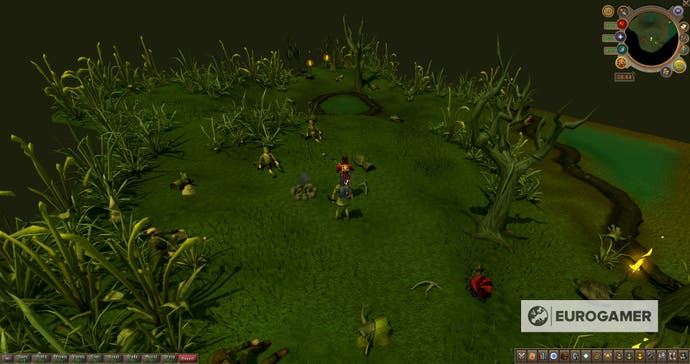
Scale theory also has a part to play when it comes to RuneScape lore as, by removing the geographical restrictions of Gielinor, the Jagex developers are, theoretically, only constrained by the established history and logic of the universe, leaving them free to mould the landscape to their will. New characters, buildings, cities and even new countries can simply be added as if they were always there, with the understanding that the scale of in-game Gielinor has simply increased to allow players to visit them. The Everlight Dig Site, which was released alongside the new Archaeology skill in March 2020, is a great example of this in action. The Everlight may have been standing on the coast of Morytania for centuries, be it beneath the wave of many years, but players have had to wait till it became significant to the stories being told in RuneScape 3 for the ability to visit it.
A similar argument can be made for the locations that exist exclusively in Old School RuneScape and vice versa, because, while both versions of RuneScape follow the same canon, they are considered different interpretations of the same universe. This means that, according to the rules of scale theory, locations like Zeah, which is exclusive to Old School, may still exist in RuneScape 3 - it simply doesn't appear on the map, because players have no reason to visit it.
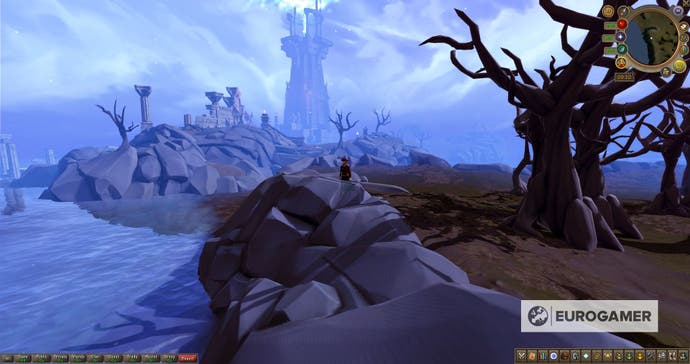
I wanted to delve deeper so, during RuneFest 2019, I asked David Osborne, lead designer of RuneScape 3, whether he had heard of scale theory. "Yes, I have," he replied. "RuneScape's unusual in the sense of how densely packed it is." I of course had to ask Osborne if he then also believed in scale theory. "We, as the designers, try to keep a version of our scale theory, yes," he confirmed.
"I actually investigated whether or not, with our engine team, we could look into a project that automated the spreading out of our game Skyrim-esc," Osborne continued, "... almost one-to-one to what it would be like to explore it naturally." Unfortunately this was not to be. "The way RuneScape works is a lot of its code is built on coordinates and actually, from an engine perspective, just automating, spreading that out, building a program that did that was not as viable as I hoped it would be."
While it's a shame we'll never get to experience Gielinor at such a grand scale, the accidental humour of the packed RuneScape map does live on; the Carnillean family of East Ardougne are seemingly unworried about the battle that rages within walking distance of their home, just like how the Varrock guard will never do anything about the dark wizards conducting evil magic right next to a city gate. Geilinor is, as Osborne aptly described, a "slightly irreverent, near Monty Python-esc version of a fantasy game world," so, in keeping with this tone, RuneScape asks you to accept these odd occurrences as simply a feature of the world and, if you can't, well there's always scale theory.
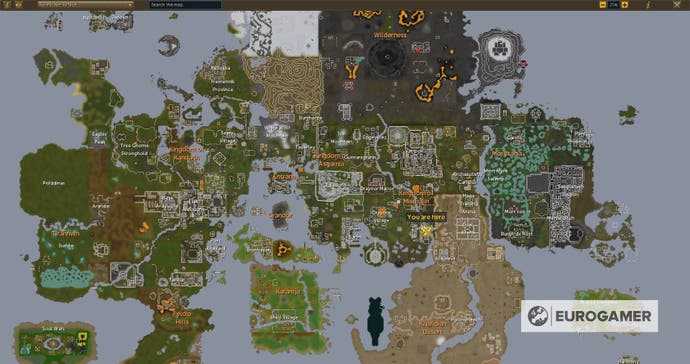
Ideas like scale theory are born from a player's desire to learn more about the game they're playing; be it by investigating the gameworld, theorising the science behind a specific mechanic, solving a narrative inconsistency or analysing the lore. A number of series have accumulated hundreds of theories with some becoming quite well known, such as 'Link is dead during the events of The Legend of Zelda: Majora's Mask' (he's not), and 'Pokémon Red, Blue and Yellow are set after a war' (possibly). Others have lesser known theories, such as my theory that the skaters in Tony Hawk's Pro Skater 1 are actually disguised aliens visiting earth to learn the radical art of skateboarding, which is why they can fall from great heights without getting hurt and why the game's last level is Roswell. (It's Area 51 - someone's clearly looking for a lift home.) Whether you believe in them or not, every theory demonstrates how immersive games and the world each one contains can be.
Personally, when it comes to scale theory, I'm a believer. I love how vast it makes Gielinor feel and adore the idea that, when visiting kingdoms like Misthalin, I'm unknowingly walking past settlements or landmarks that may appear on the map one day. Traversing familiar routes, like travelling north from Yanville to East Ardougne, still feels exciting and, although I've been looking at the Gielinor map for years, it's never felt static. There's an element of life to the map, as if a new location could emerge at any moment. I've also always had a love for fantasy world maps and used to spend hours crafting my own as a child. Scale theory brings an essence of mystery to a game I know well and accepting it allows me to focus my lore knowledge onto exploring RuneScape's bigger question, like horses - are they a myth or simply extinct?
